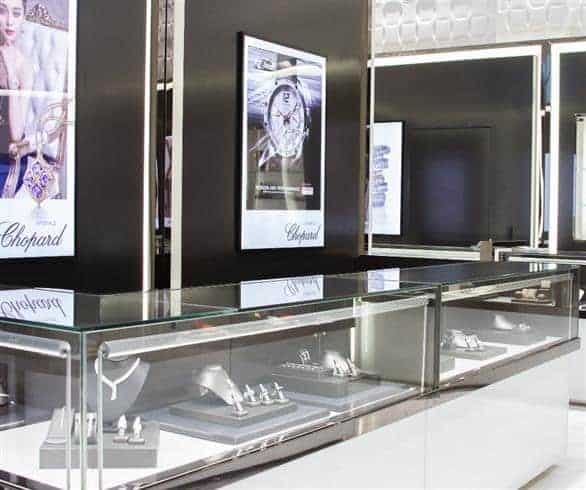
(Photo: L’oro Jewellery)
Which merchandise should be the star of your showcase—and why
BY: Larry Johnson
For years, I have suggested to jewellers that they place the product they want to sell the most on an individual element in the “sweet spot” of their showcase. Located at the back centre of the case, this position is the most invaluable part of your display—as a focal point, it increases an item’s odds of being sold, simply because more visual traffic comes its way.
To increase the success of this strategy—and sell the expensive, high-end items you’re hoping to—display your more costly items in the sweet spot. This way, the pieces will be more noticeable amidst a sea of other items, and you can most effectively match your sales strategy to your showcase. Likely, the salesperson pitching the piece will discuss its exclusivity, quality and special nature of the piece, and this unique display method supports that.
Recently, I found good reason to rethink the implementation of this strategy to appeal to different clientele. The store that precipitated this change—one of my clients—is modestly sized and located in a small town with a declining population. There are no other jewellers there, save for the jewellery department of the local Walmart. Moderate to higher income families have shopped at the client’s store for decades; the issue is that the aggregate number of those shoppers is shrinking rapidly, and the jeweller’s business volume is insufficient to support the store. Additionally, lower income shoppers in town have always assumed that the merchandise at this “fine jewellery” store was priced outside of their reach.
If this client wished to increase its sales to those lower-middle income shoppers, the strategy of emphasizing a high-ticket item front and center would have been misguided. This way, prospective customers entering the store would see the expensive piece and feel that they were in the wrong place.
The owners of the store and I met and discussed the options available to us to attract price-sensitive shoppers.
Our game plan was as follows:
1.) We took a step back to evaluate our situation. We had to realize that the business was involved in a classic one-on-one competition with a retail giant. We needed to develop a very good understanding of what our competitor offered in quality, selection and price. Could we compete on price on any of the categories? What additions to our selection did we need to make to compete directly?
2.) We realized that like many corporate retailers, Walmart offers attractive financing options that increase their sales. Our store needed to step up the promotion of its jewellery with in-store financing starting at an attractive rate. This allowed us to begin advertising on local billboards.
3.) The display strategy needed to change. We had triple the amount of display space of our competitors, and we made sure we utilized each case to emphasize pieces that competed directly and positively with Walmart. These pieces were organized to accompany items priced 20% higher to give the sales team an opportunity to up-sell and to make the selling process smoother. We also put signage in the showcases that reinforced our selling points to shoppers as they perused the cases.
4.) We made sure that each sales person had a concise, accurate sales presentation to accompany each comparison for our competitive pieces.
5.) We had the sales team spend time in Walmart to examine their selection and learn about their prices. The sales team took additional sales training courses with an emphasis on dealing with price objections. The team needed to enhance their gemological training to be authoritative in jewellery knowledge and to communicate that information in a way to increase sales.
6.) We scheduled some invitation-only high-end events for more affluent clientele, during which we emphasized current stock or brought in pieces that would appeal to them. This ensured that our regular clients knew we still had items for them.
7.) We set a 90-day timeframe to track the impact of these changes and adjust as needed. Then, we ran a current “inventory performance by category” report from the clients EDGE reporting system to give us a basis to measure against.
The results of this particular effort are still forming. However, through this experience, I realized that this strategy can still be utilized by any jeweller: the principles applied are universal. Regardless of your market conditions, use this method to find the sweet spot in your sales revenue.
















